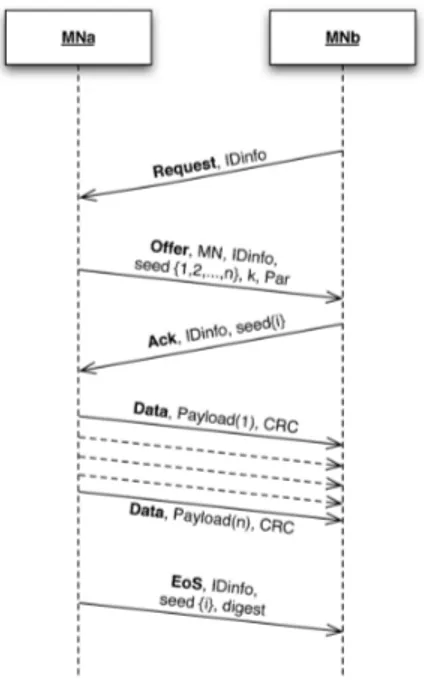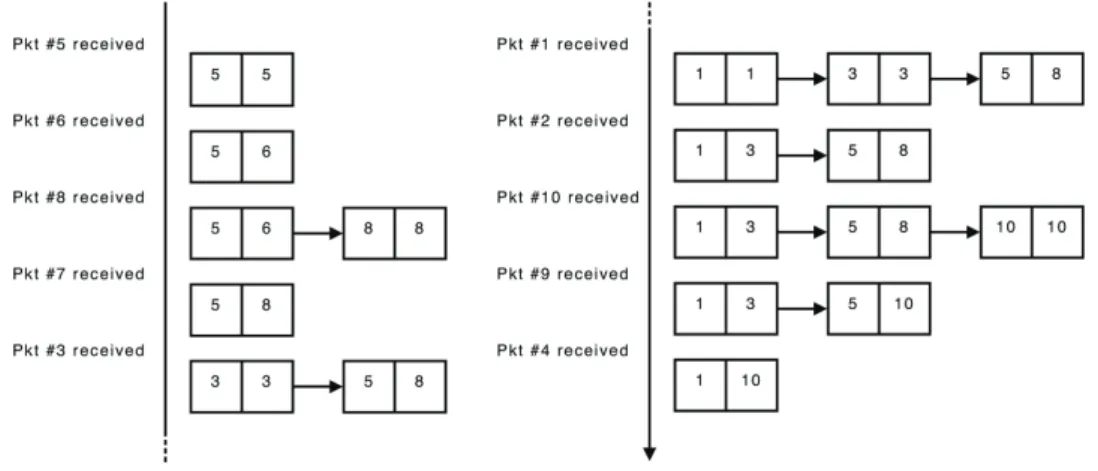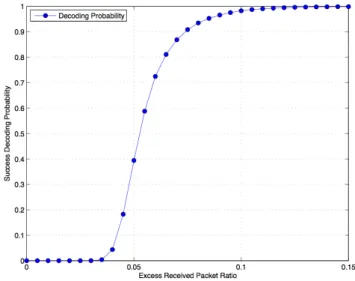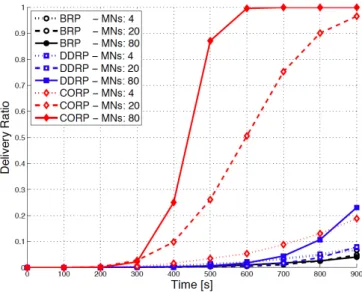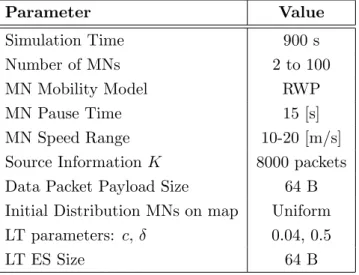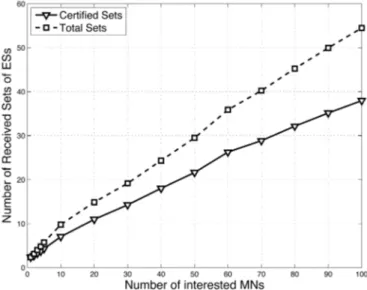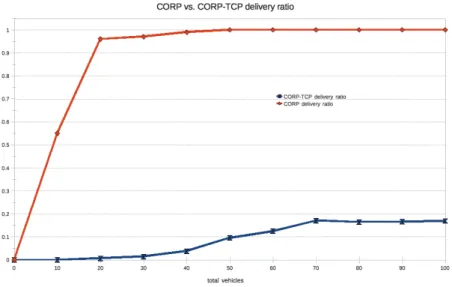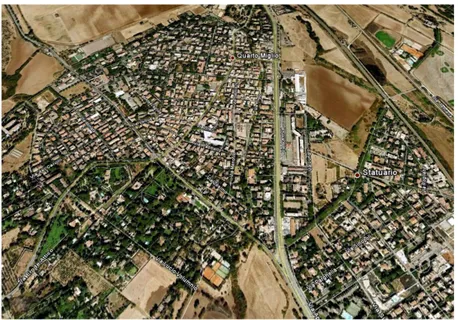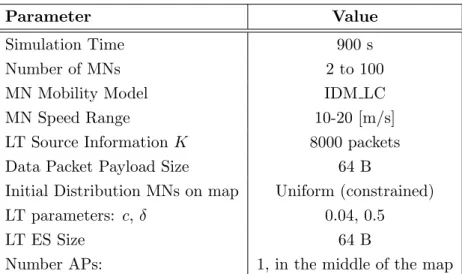receives a broadcast Request packet from another MN, it responds with a Offer packet
containing the list of the generation seeds of the certified sets belonging to the requested
file and specifying that it does not have the whole le. The requesting node will choose
Figure 6.9: MN to MN communication. The figure shows the sequence diagram of
the communication among mobile nodes in CORP.
one of the seeds and the sending node will start to transmit the ESs belonging to the set
until one of the conditions presented in section 6.2.5.1 occur or if the sending node has
sent all the ESs belonging to that set. In the latter case, the sending node transmits
a EoS packet containing the digest of the provided set. At this point, the receiver,
computes the digest of the set based on the ESs that it has received. If the computed
digest matches the one contained in the EoS packet, then the set is certified and can
be disseminated.
However, if there is no match between the two digests, then the node will not be
able to disseminate the set but the ESs will be equally useful for the decoding of the
information block. In the case where one node owns the whole information, this node
answer to a Request by providing a unique generation seed and specifying that it owns
the whole information. From this point the communication algorithm works exactly as
specified in section 6.2.5.1.
6.2.6
CORP-TCP
CORP-TCP is a data dissemination protocol designed and implemented in order to
evaluate CORP performances. In the next section we present the major outcome of
the simulations carried out to compare CORP to I2V and V2V approaches. However,
an additional comparison with a similar I2V2V was originally missing and CORP-TCP
was what we really needed to highlight the benefits of our protocol.
The main difference between CORP and CORP-TCP is the transport protocol used
at lower layer. In fact, while the former is developed on the top of UDP, the latter is
completely designed to work on TCP. Clearly, by involving a complex transport layer
such as TCP, the need of a coding scheme was not required anymore. According to
CORP-TCP, the only information that has to be carried out is the fragmentation of
the information S into smaller k fragments and the key idea behind this protocol is
similar to the well-known P2P: if a vehicle moving in the simulation area is interested
to a resource advertised by the AP, it simply start to download it. However, differently
from CORP, it constantly keeps track of the received fragments so that it can ask later
for the missing ones (see Figure 6.10). It is important to highlight that the missing
fragments can be request either to an AP or another mobile node, in a I2V2V fashion.
Figure 6.10: CORP-TCP. In CORP-TCP every mobile node has to keep track of the
downloaded fragments. Each mobile node saves the first and the last fragment missing
(that is the missing interval). The figure shows an example of a 10 fragments resource.
some important changes like the lack of the CRC field, which is not needed as such a
checksum function is already provided by the TCP protocol. Another important change
is the introduction of the Connection table and the Service table. The former is used
to keep track of the connection with the other mobile nodes and it is made up of the
following fields:
• Connection ID: the identifier of the connection with another vehicle;
• Local Address: the local interface IP address;
• Remote Address: the remote interface IP address related to a certain Connection
ID;
• Active: this field is ”true” if the connection is active, ”false” otherwise.
An example of the Connection table is provided in Tab. 6.3.
Connection ID
Local Address
Remote Address
Active
1
192.168.0.10
192.168.0.11
true
2
192.168.0.10
192.168.0.14
false
..
.
..
.
..
.
..
.
n
192.168.0.10
192.168.0.32
true
Table 6.3: Example of a Connection table used in CORP-TCP.
The latter, instead, contains information related to the Services. An example of
said table is provided in Tab. 6.4.
ID
inf oFragments list
Completed
Interesting
Requested
1
*list
true
true
true
2
*list
false
true
true
..
.
..
.
..
.
..
.
..
.
n
*list
false
true
true
Table 6.4: Example of a Service table used in CORP-TCP.
The contains the following fields:
• Fragments list: the pointer to a sequenced list containing the sequence number
of the received fragments;
• Completed: this field is ”true” if the service has been successfully downloaded,
”false” otherwise;
• Interesting: this field is ”true” if the node is interested in that service, ”false”
otherwise;
• Requested: this field is ”true” if the service has been successfully requested, ”false”
otherwise.
6.2.7
Simulations and results
In order to evaluate the performance of CORP, we modelled the system as a
wire-less ad hoc network with several MNs and a fixed AP. We considered the nodes to be
equipped with omnidirectional radio transmitters with a nominal 216 meters
radior-ange and capable to reach a maximum bandwidth of 2Mbps. The transmission is UDP
based and the performance of the system is simulated with QualNet network
simula-tor. We assume that MNs can move freely (with speed ranging from 10 to 20 m/s and
maximum pause-time of 15 seconds) within a 3000x3000 m wide area according to the
RWP model. Instead, the AP is fixed and located in the center of the map in order to
maximize the number of times a MN can communicate with it.
The application we considered for the simulation is the advertisement by a
restau-rant of a particular menu for lunch. The menu is contained in a 512KB image file
that will be delivered in the said area to all the vehicles interested in that service. We
performed 15 minutes simulations with a number of interested vehicles ranging from 2
to 100 and then we compared CORP to other two approaches. The first one is a basic
scheme of information dissemination from the AP using rateless codes. This approach
is not collaborative and vehicles can recover the information as soon as they have
re-ceived enough ESs. We call this approach BRP. The second approach is DDRP, where
nodes can exchange information only if they have successfully decoded the file.
Among the rateless codes implementations presented in literature, in the simulations
we decided to use LT codes (58) as they represent the first implementation of the digital
Figure 6.11: CORP. Cumulative success decoding probability distribution as a function
of the excess received packets ratio wih 8000 source packets of 64 Bytes.
Figure 6.12: CORP delivery ratio. The figure shows the delivery ratio as a function
of the number of cooperative MNs in the simulated area after 15 minutes.
Figure 6.13: CORP delivery ratio. The figure shows the delivery ratio as a function
of the time for different numbers of collaborating nodes.
Three density scenarios are
considered with respect to the number of mobile nodes: M N s = 4 (dotted lines), M N s =
20 (dashed lines) or M N s = 80 (continuous lines).
fountain coding mechanism.
The decoding performance of the adopted LT code is presented in Fig. 6.11. In this
gure it is shown the probability of decoding as function of the extra packets ratio needed
to recover the source information. As we can observe, most decoding processes succeed
when the number of excess ESs is between 4% and 7%.
As it concerns the simulation parameters related to fountain coding are grouped in
a quadruplet: (K; δ; c; l) = (8000; 0.5; 0.04; 64); the variable K represents the number
of source packets of l bytes that form the information, while d and c are the parameters
of the Robust Soliton Degree Distribution.
In order to cope with fading, multipath and high dynamism effects - which in vehicular
networks can dramatically increase the bit error rate and, therefore, the packet loss
rate (49) -, the dimension of data packets is rather small (64 bytes). As a consequence,
by increasing reliability, the drawback is the decrease of efficiency due to the high
packet overhead. the main simulation parameters are grouped in Tab.6.5 while Fig.
6.12 depicts the delivery ratio as a function of the number of cooperative MNs in the
simulated area after 15 minutes. It is important to highlight that the delivery ratio is
intended as the ratio of MNs which successfully decoded the information over the total
number of interested vehicles in the area.
Fig. 6.12 shows that that CORP performs better than the other approaches; while the
CORP graph is monotonically increasing, the delivery ratio of the other two approaches
is first growing and then it shows a decreasing trend.
With CORP, the collaboration of only 20 MNs is sufficient enough to recover the source
information with a probability of 96%. Furthermore, delivery ratio is 1 even if the
number of the interested nodes increases. On the other hand, when the DDRP approach
is adopted, the average delivery ratio curve is increasing only when the number of MNs
is lower than 70. However, also for few nodes, its cooperation policy is not satisfactory
for the information reception. In particular, when more than 70 MNs are collaborating,
the delivery ratio decreases. This happens because too many MNs are connected to the
AP at the same time.
Parameter
Value
Simulation Time
900 s
Number of MNs
2 to 100
MN Mobility Model
RWP
MN Pause Time
15 [s]
MN Speed Range
10-20 [m/s]
Source Information K
8000 packets
Data Packet Payload Size
64 B
Initial Distribution MNs on map
Uniform
LT parameters: c, δ
0.04, 0.5
LT ES Size
64 B
Table 6.5: CORP simulation parameters used in Qualnet.
As a consequence, the amount of packets transmitted to each node from the AP
decreases, thus requiring longer time to retrieve the file.
Finally, it is possible to take some consideration on BRP, which performs rather worse
with respect to the others; in this case, the delivery ratio, which is almost constant
up to 60 nodes, starts to decrease as the collaborating nodes increase, thus reducing
the overall performance because the AP is required to handle too many connections at
the same time. Clearly, this yields to a reduction of the bandwidth the AP allocates
to each mobile connection. Furthermore, in the presence of parallel connections, the
channel’s contention greatly reduce the available bandwidth, thus further decreasing
the delivery ratio.
Fig. 6.13 shows the trend of the delivery ratio as a function of the time over the
col-laborating nodes. In this respect, three density scenarios are considered: 4 (dotted
lines), 20 (dashed lines) and 80 (continuous lines) MNs. It is valuable to notice that
the collaboration policy in CORP allows a major improvement of the delivery ratio
with respect to the one used in DDRP. In particular, with only 4 MNs it is possible
to reach the same performace of the DDRP solution with 80 MNs. Furthermore, with
CORP, 10 minutes (simulation time) are enough to grant all the 80 MNs to receive
and reassemble the relative information, while hte same amount of time is completely
inadequate in the other approaches. In Fig. 6.14 we present the average number of sets
Figure 6.14: Number of Received Sets of ESs. The figure shows the total sets’
number owned by each mobile node).
owned by each MN. In particular, the figure shows the total number of sets and the
number of certified sets. As we can see, the trend for both graphs is linear. Moreover,
the ratio between the number of certified sets and the total number of sets is almost
constant.
Finally, in Fig. 6.15 we can see the average size of the shared ESs sets. In this case,
the set size decreases as the number of nodes increases, which means that the AP is
correctly allocating the avaliable bandwidth among the connected MNs. However, this
Figure 6.15: Average Set size in CORP. The figure shows the average set size over
the number of mobile nodes. The set size decreases as the number of nodes increases, which
improves the overall dissemination speed.
Figure 6.16: CORP vs. CORP-TCP delivery ratio. The figure shows the delivery
ratio trend for CORP and CORP-TCP.
Figure 6.17: Aerial view of the simulation area. The figure shows the Google
Earth aerial view of the simulation area. The related map in (Open Street Map) has been
subsequently cropped and imported in Vanetmobisim in order to generate realistic mobility
traces.
yields less delivered packets per connection, (i.e., the sets are smaller) but, on the other
hand, this improve also the dissemination speed. In order to compare CORP to a
simi-lar I2V2V approach, we ran CORP-TCP simulations with the same scenario previously
used with CORP and then we compared the delivery ratio of the two protocols. The
comparison is shown in Fig. 6.16. The results show that CORP-TCP delivery ratio is
clearly affected by the absence of any kind of coding and, which is most, by the TCP
protocol with its intrinsic characteristics, namely, the three way handshake mechanism,
the four-way connection closing mechanism and the slow start/restart mechanism.
The need of stronger and more accurate simulation results led us to test both CORP
and CORP-TCP protocol in a pseudo-real scenario. As a consequence, we imported
a real city map from Open Street Map (OSM), which was subsequently cropped and
exported as XML to Vanetmobisim(35) traffic simulator (fig. 6.19). In fig. 6.17 you
can see the aerial view of the simulation area while in fig. 6.18 there is the related 2-D
map. Once imported in Vanetmobisim, the map was then used to generate the realistic
mobility patterns of the vehicles, taking into account both the speed limits, and the
traffic lights (one per each intersection). The mobility model is the Intelligent Driver
Model with Lane changes (IDM LC(35), see section 4.2.4.1). This mobility model,
extends the IDM IM model (which, in turn adds intersection handling capabilities to
the behavior of vehicles driven by the IDM scenarios) with the possibility for vehicles
to change lane and overtake each others.
Parameter
Value
Simulation Time
900 s
Number of MNs
2 to 100
MN Mobility Model
IDM LC
MN Speed Range
10-20 [m/s]
LT Source Information K
8000 packets
Data Packet Payload Size
64 B
Initial Distribution MNs on map
Uniform (constrained)
LT parameters: c, δ
0.04, 0.5
LT ES Size
64 B
Number APs:
1, in the middle of the map
Table 6.6: CORP and CORP-TCP simulation parameters used in Qualnet with the
IDM LC mobility pattern.
The parameters used for the simulation environment are shown in table 6.6.
Results (fig. 6.21) show that CORP performs very well in the simulated scenario, and
it really benefits from the FC coding. The difference in terms of delivery ratio between
the two protocols prove, once again, that TCP intrinsic characteristics such as slow
start-restart, three-way-handshake and four-way-disconnection are not suitable for a
high dynamic scenario. With reference to fig. 6.21, please note that the delivery ratio
starts decreasing when mobile nodes are more than 80-85. This effect is due to the
high congestion caused by traffic lights. As a consequence, given that there is no active
routing protocol, if vehicles stuck into the traffic the data dissemination process can be
extremely difficult.
Furthermore, it is noticeable that CORP delivery ratio never reach 100% if compared to
former results with RWP. This is because simulation has some minor flaws in mobility
and few vehicles remain isolated and ”far” from every other node in the area. Probably,
this effect can be tricked with the use of straight maps.
Figure 6.18: Imported map for mobility trace. The figure shows the map of the
simulation area (it is a real map which includes two districts,”Statuario” and ”Quarto
Miglio”).
Finally, we can say that the results registered by CORP are good and show that
fountain code approach is suitable for data dissemination in vehicular ad-hoc networks.
Figure 6.19: Realistic mobility pattern. The figure shows the mobility pattern
gen-erated on a real map, according to the IDM LC mobility model (The red dots represent
the constrained vehicles moving across roadmap during the simulation.). This trace has
been used to compare CORP and CORP-TCP performances.
Figure 6.20: Realistic mobility pattern - Detailed view. The figure shows the
situ-ation of the mobility pattern generated on a real map, according to the IDM LC mobility
model (The red dots represent the constrained vehicles moving across roadmap during the
simulation.).
Figure 6.21: CORP vs. CORP-TCP delivery ratio with a realistic mobility
model (IDM LC). The figure shows the delivery ratio trend for CORP and CORP-TCP;
simulations have been performed under a realistic mobility model such as the IDM LC.
Conclusions
In this thesis we faced the problem of efficiently disseminate data in vehicular networks.
Achieving this goal in a wireless environment usually involves a lot of challenging issues
mainly due to the characteristics of the medium and the lack of synchronization and
organization among nodes.
This is even more challenging in vehicular networks, as the nodes can move at high
speed in a wide area surrounded of buildings and many other architectural structures
which can, in turn, affect the propagation of the radio signal.
As a consequence, we introduced an innovative method based on rateless codes for
a reliable and efficient data dissemination in vehicular networks: ”CORP”
(Coopera-tive Rateless Protocol). Our approach, which is designed on the top of UDP transport
protocol, exploits the collaboration among vehicles in order to quickly disseminate an
information on a wide area and represents the first successful application of the Fountain
Codes theory to the vehicular field which totally complies with the
infrastructure-to-vehicle-to-vehicle communication paradigm (I2V2V).
The validity of CORP was confirmed through extensive simulation with Qualnet
4.5, an excellent simulator which includes several libraries for accurate modeling of
mobility and radio propagation effects.
The collected results show that CORP leads to an efficient dissemination in terms
of both speed and reliability. In particular, the more vehicles cooperate, the faster the
dissemination. Furthermore, CORP performs better than other similar approaches,
namely V2V, I2V and TCP based file sharing, even when only a limited number of
vehicles cooperates. For example, 30 mobile nodes moving in a 3000x3000 m area (i.e.
a car every 550 square meters on average) according to the RWP mobility model is
enough to deliver an information among all the vehicles whithin 15 minutes. Slightly
different is the situation in case of pseudo-real mobility trace (IDM LC mobility model),
where at least 50 cooperating nodes in a 1700x300 m area are needed in order to reach
a delivery ratio of about 96%.
Additional measurements and analysis are being performing in order to investigate
the impact of other relevant key parameters on the protocol, namely:
• the beaconing time for neighbors discovering;
• the frequency of the advertisement message sent by the AP to promote the service;
• the frequency of the periodic request packets;
• the influence of the transmission parameters such as power transmission;
• the packet size to be transmitted and the service size to be disseminated.
Future work will be mainly focused on the performance analysis of the protocol
in real scenarios (i.e. rural, city, urban and freeway), with respect to the effects on
signal transmission caused by architectural environment and surrounding buildings. In
addition to simulation, the deployment of CORP protocol on a real vehicular testbed
is currently being developed, thanks to the cooperation of University of Rome Tor
Vergata, University of California Los Angeles (UCLA) and the Mobile Communications
Department at EURECOM (France).
[1] Canumobisim Vehicular Mobility Simulator Environment, avaliable at http://canu.informatik.uni-stuttgart.de/mobisim/. 73, 77
[2] Glomosim network simulator. 45, 73 [3] The network simulator - NS2. 45, 58, 73 [4] Qualnet network simulator. 45, 73 [5] TSIS-CORSIM. 69
[6] U.S. Census Bureau Tiger System Database. 73
[7] ASH: Application-aware SWANS with highway mobility, 2008. 68, 93, 99
[8] IEEE Standard for Information technology–Telecommunications and information exchange between systems–Local and metropolitan area networks–Specific requirements Part 11: Wireless LAN Medium Access Control (MAC) and Physical Layer (PHY) Specifications Amendment 5: Enhancements for Higher Throughput. IEEE Std 802.11n-2009 (Amendment to IEEE Std 802.11-2007 as amended by IEEE Std 802.11k-2008, IEEE Std 802.11r-2008, IEEE Std 802.11y-2008, and IEEE Std 802.11w-2009), pages c1 –502, 29 2009. 22
[9] Rudolf Ahlswede, Ning Cai, Shuo yen Robert Li, Raymond W. Yeung, Senior Member, and Senior Member. Network information flow. IEEE Transactions on Information Theory, 46:1204– 1216, 2000. 117, 118, 124
[10] Mohiuddin Ahmed, Cem U. Saraydar, Tamer Elbatt, Jijun Yin, Timothy Talty, and Michael Ames. Intra-vehicular Wireless Networks. 28
[11] O. Andrisano, R. Verdone, and M. Nakagawa. Intelligent transportation systems: the role of third generation mobile radio networks. Communications Magazine, IEEE, 38(9):144 –151, sep 2000. 36
[12] A. Bachir and A. Benslimane. A multicast protocol in ad hoc networks inter-vehicle geocast. In Vehicular Technology Conference, 2003. VTC 2003-Spring. The 57th IEEE Semiannual, 4, pages 2456–2460 vol.4, April 2003. 101
[13] Rimon Barr, Zygmunt J. Haas, and Robbert van Renesse. Scalable Wireless Ad hoc Network Simu-lation, chapter 19, pages 297–311. CRC Press, August 2005. 91
[14] Christian Bettstetter. Smooth is better than sharp: a random mobility model for simulation of wireless networks. In MSWIM ’01: Proceedings of the 4th ACM international workshop on Modeling, analysis and simulation of wireless and mobile systems, pages 19–27, New York, NY, USA, 2001. ACM. 77
[15] Jean-Yves Le Boudec and Milan Vojnovic. The random trip model: stability, stationary regime, and perfect simulation. IEEE/ACM Trans. Netw., 14(6):1153–1166, 2006. 55, 57
[16] Azzedine Boukerche, Horacio A.B.F. Oliveira, Eduardo F. Nakamura, and Antonio A.F. Loureiro. Vehicular Ad Hoc Networks: A New Challenge for Localization-Based Systems. Computer Communications, 31(12):2838 – 2849, 2008. Mobility Protocols for ITS/VANET. 12
[17] John W. Byers, Michael Luby, Michael Mitzenmacher, and Ashutosh Rege. A digital foun-tain approach to reliable distribution of bulk data. In SIGCOMM ’98: Proceedings of the ACM SIGCOMM ’98 conference on Applications, technologies, architectures, and protocols for computer com-munication, pages 56–67, New York, NY, USA, 1998. ACM. 141
[18] R. Diaconescu V. Cristea C. Gorgorin, V. Gradinescu and L. Ifode. An Integrated Vehicular and Network Simulator for Vehicular Ad-Hoc Networks. Proceedings of the 20th European Simulation and Modelling Conference, October 2006. 59
[19] P. Cataldi, A. Tomatis, G. Grilli, and M. Gerla. CORP: Cooperative rateless code protocol for vehicular content dissemination. pages 1 –7, 29 2009-july 1 2009. 1, 144
[20] P. Cataldi, A. Tomatis, G. Grilli, and M. Gerla. A Novel Data Dissemination Method for Vehicular Networks with Rateless Codes. In Wireless Communications and Networking Conference, 2009. WCNC 2009. IEEE, pages 1–6, April 2009. 115, 117
[21] David R. Choffnes and Fabi´an E. Bustamante. An integrated mobility and traffic model for vehicular wireless networks. In VANET ’05: Proceedings of the 2nd ACM international workshop on Vehicular ad hoc networks, pages 69–78, New York, NY, USA, 2005. ACM. 58, 59, 94
[22] F. Delamare, F.L. Dotti, P. Fernandes, C.M. Nunes, and L.C. Ost. Analytical modeling of random waypoint mobility patterns. In Proceedings of the 3rd ACM international workshop on Performance evaluation of wireless ad hoc, sensor and ubiquitous networks, pages 106–113. ACM New York, NY, USA, 2006. 146
[23] Ros G. Dimakis, Vinod Prabhakaran, and Kannan Ramch. Ubiquitous access to distributed data in large-scale sensor networks through decentralized erasure codes. pages 111–117, 2005. 126
[24] Tamer Elbatt, Siddhartha K Goel, Gavin Holl, Hariharan Krishnan, and Jayendra Parikh. Cooperative Collision Warning Using Dedicated Short Range Wireless Communications. In In VANET, pages 1–9. ACM Press, 2006. 10
[25] Ahmed Helmy Fan Bai, Narayanan Sadagopan. IMPORTANT: A framework to systematically analyze the Impact of Mobility on Performance of Routing protocols for Adhoc NeTworks. pages 825–835, 2003. 54, 55, 61, 64, 65
[26] E. Fasolo, M. Rossi, J. Widmer, and M. Zorzi. In-network aggregation techniques for wireless sensor networks: a survey. Wireless Communications, IEEE, 14(2):70–87, April 2007. 116
[27] Jon Feldman, Tal Malkin, Rocco A. Servedio, and Cliff Stein. Secure Network Coding via Filtered Secret Sharing, 2004. 126
[28] Marco Fiore, Claudio Casetti, and Carla-Fabiana Chiasserini. On-demand content delivery in vehicular wireless networks. In MSWiM ’05: Proceedings of the 8th ACM international symposium on Modeling, analysis and simulation of wireless and mobile systems, pages 87–94, New York, NY, USA, 2005. ACM. 113
[29] Christina Fragouli, Jean-Yves Le Boudec, and J¨org Widmer. Network coding: an instant primer. SIGCOMM Comput. Commun. Rev., 36(1):63–68, 2006. 120
[30] Christina Fragouli, Athina Markopoulou, ´Ecole Polytechnique, and F´ed´erale Lausanne. A network coding approach to overlay network monitoring. In In Allerton, 2005. 126
[31] Christina Fragouli and J¨org Widmer. A Network Coding Approach to Energy Efficient Broadcasting: from Theory to Practice. In In Proc. of IEEE INFOCOM. IEEE Computer Society, 2006. 125
[32] Christina Fragouli and J¨org Widmer. On the Benefits of Network Coding for Wireless Ap-plications. In In 4th International Symposium on Modeling and Optimization in Mobile, Ad Hoc and Wireless Networks, pages 1–6, 2006. 125
[33] Mario Gerla, Ken Tang, and Rajive Bagrodia. TCP Performance in Wireless Multi-hop Networks. pages 41–50, 1999. 129
[34] Christos Gkantsidis, John Miller, and Pablo Rodriguez. Comprehensive view of a live network coding P2P system. In IMC ’06: Proceedings of the 6th ACM SIGCOMM conference on Internet measurement, pages 177–188, New York, NY, USA, 2006. ACM. 126
[35] J. H¨arri, F. Filali, C. Bonnet, and Marco Fiore. VanetMobiSim: generating realistic mobility patterns for VANETs. In VANET ’06: Proceedings of the 3rd international workshop on Vehicular ad hoc networks, pages 96–97, New York, NY, USA, 2006. ACM. 73, 146, 165, 166
[36] Tracey Ho, Ralf Koetter, Muriel M´edard, David R. Karger, and Michelle Effros. The bene-fits of coding over routing in a randomized setting. In In Proceedings of 2003 IEEE International Symposium on Information Theory, 2003. 123
[37] Tracey Ho, Ben Leong, Ralf Koetter, Muriel Medard, Michelle Eros, and David R. Karger. Byzantine Modification Detection in Multicast Networks using Randomized Network Cod-ing. In in IEEE Proc. Intl. Sym. Inform. Theory, page 143, 2004. 126
[38] B. Hoh, M. Gruteser, H. Xiong, and A. Alrabady. Enhancing Security and Privacy in Traffic-Monitoring Systems. Pervasive Computing, IEEE, 5(4):38 –46, oct.-dec. 2006. 36
[39] Xiaoyan Hong, Mario Gerla, Guangyu Pei, and Ching-Chuan Chiang. A group mobility model for ad hoc wireless networks. In MSWiM ’99: Proceedings of the 2nd ACM international workshop on Modeling, analysis and simulation of wireless and mobile systems, pages 53–60, New York, NY, USA, 1999. ACM. 50, 65
[40] Xiaoyan Hong, Taek Jin Kwon, Mario Gerla, Daniel Lihui Gu, and Guangyu Pei. A Mobility Framework for Ad Hoc Wireless Networks. In MDM ’01: Proceedings of the Second International Conference on Mobile Data Management, pages 185–196, London, UK, 2001. Springer-Verlag. 65 [41] Barbara Hughes, Ren´e Meier, Raymond Cunningham, and Vinny Cahill. Towards real-time
middleware for vehicular ad hoc networks. In VANET ’04: Proceedings of the 1st ACM international workshop on Vehicular ad hoc networks, pages 95–96, New York, NY, USA, 2004. ACM. 12
[42] International Symposium on Communications Internetworking. Performance evaluation of TCP over UMTS transport channels Channels, Ottawa - Canada, November/December 2004. 10
[43] J. Byers, J. Considine, M. Mitzenmacher, S. Rost. Informed Content Delivery Across Adaptive Overlay Networks. In ACM SIGCOMM 2002, Pittsburgh - Pennsylvania - USA, 2002. 147
[44] David B. Johnson and David A. Maltz. Dynamic source routing in ad hoc wireless networks. In Mobile Computing, pages 153–181. Kluwer Academic Publishers, 1996. 45, 57, 73
[45] Frank Kargl and Elmar Schoch. Simulation of MANETs: a qualitative comparison between JiST/SWANS and ns-2. In MobiEval ’07: Proceedings of the 1st international workshop on System evaluation for mobile platforms, pages 41–46, New York, NY, USA, 2007. ACM. 91
[46] F.K. Karnadi, Zhi Hai Mo, and Kun chan Lan. Rapid Generation of Realistic Mobility Models for VANET. Wireless Communications and Networking Conference, 2007.WCNC 2007. IEEE, pages 2506–2511, March 2007. 81
[47] Brad Karp and H. T. Kung. GPSR: greedy perimeter stateless routing for wireless networks. In MobiCom ’00: Proceedings of the 6th annual international conference on Mobile computing and net-working, pages 243–254, New York, NY, USA, 2000. ACM. 40
[48] Wolfgang Kiess and Martin Mauve. On the nature of Inter-Vehicle Communication, February-March 2007. 36
[49] J. Korhonen and Y. Wang. Effect of packet size on loss rate and delay in wireless links. 3, pages 1608 – 1613 Vol. 3, march 2005. 161
[50] Dejan Kostic, Adolfo Rodriguez, Jeannie Albrecht, and Amin Vahdat. Bullet: High Bandwidth Data Dissemination Using an Overlay Mesh. In In SOSP, 2003. 147
[51] Stefan Krauss. Microscopic Modelling of Traffic Flow: Investigation of Collision Free Vehicle Dynamics. PhD thesis, 1998. 80
[52] Jesse Landman and Pieter Kritzinger. Delay analysis of downlink IP traffic on UMTS mobile networks. Performance Evaluation, 62(1-4):68 – 82, 2005. Performance 2005. 13
[53] Zhang-W. Festag A. Le, L. and R. Baldessari. Analysis of Approaches for Channel Allocation in Car-to-Car Communication. In 1st I nternational Workshop on 1st International Workshop on Interoperable Vehicles, March 2008. 32
[54] Festag A. Le L., Zhang W. and Baldessari R. Analysis of Approaches for Channel Allocation in Car-to-Car Communication Allocation in Car-to-Car Communication. 1st International Workshop on Interoperable Vehicles, March 2008. 35
[55] Uichin Lee, Joon-Sang Park, Joseph Yeh, Giovanni Pau, and Mario Gerla. Code torrent: con-tent distribution using network coding in VANET. In MobiShare ’06: Proceedings of the 1st international workshop on Decentralized resource sharing in mobile computing and networking, pages 1–5, New York, NY, USA, 2006. ACM. 113, 115
[56] Minghong Lin, Bin Fan, John C. S. Lui, and Dah-Ming Chiu. Stochastic analysis of file-swarming systems. Perform. Eval., 64(9-12):856–875, 2007. 145
[57] Changdong Liu, M.J. Lee, and T.N. Saadawi. A scalable multicast routing. 2, pages 983 –987 vol.2, nov 1997. 40
[58] M. Luby. LT codes. Foundations of Computer Science, 2002. Proceedings. The 43rd Annual IEEE Symposium on, pages 271–280, 2002. 136, 138, 148, 159
[59] M. Luby, M. Watson, T. Gasiba, T. Stockhammer, and Wen Xu. Raptor codes for reliable download delivery in wireless broadcast systems. Consumer Communications and Networking Conference, 2006. CCNC 2006. 3rd IEEE, 1:192–197, Jan. 2006. 143
[60] P. Manzoni M. Sanchez. A Java-based ad-hoc networks simulator. SCS Western Multiconference, 1999. 44, 73
[61] Atulya Mahajan, Niranjan Potnis, Kartik Gopalan, and Andy Wang. Urban Mobility Models for VANETs. In Proc. of Workshop on Next generation Wireless Networks (WoNGen), December 2006. 53
[62] C. Maihofer. A survey of geocast routing protocols. Communications Surveys Tutorials, IEEE, 6(2):32 –42, quarter 2004. 13
[63] Rahul Mangharam, Daniel Weller, Raj Rajkumar, Priyantha Mudalige, and Fan Bai. GrooveNet: A Hybrid Simulator for Vehicle-to-Vehicle Networks (Invited Paper). 95 [64] Rahul Mangharam, Daniel S. Weller, Daniel D. Stancil, Ragunathan Rajkumar, and
Jayen-dra S. Parikh. GrooveSim: A Topography-Accurate Simulator for Geographic Routing in Vehicular Networks. In in Proceedings of the 2nd ACM International Workshop on Vehicular Ad Hoc Networks, pages 59–68, 2005. 95
[65] B.M. Masini, C. Fontana, and R. Verdone. Provision of an emergency warning service through GPRS: performance evaluation. pages 1098 – 1102, oct. 2004. 36
[66] P. Maymounkov. Online Codes. Tr2002-833, New York University, November 2002. 136, 148 [67] Petar Maymounkov and David Mazieres. Rateless Codes and Big Downloads. In In IPTPS’03,
2003. 147
[68] A. Nandan, S. Das, G. Pau, M. Gerla, and M.Y. Sanadidi. Co-operative downloading in vehic-ular ad-hoc wireless networks. In Wireless On-demand Network Systems and Services, 2005. WONS 2005. Second Annual Conference on, pages 32–41, Jan. 2005. 113, 114, 115, 127
[69] Valery Naumov, Rainer Baumann, and Thomas Gross. An evaluation of inter-vehicle ad hoc networks based on realistic vehicular traces. In MobiHoc ’06: Proceedings of the 7th ACM inter-national symposium on Mobile ad hoc networking and computing, pages 108–119, New York, NY, USA, 2006. ACM. 11, 61
[70] B. Clifford Neuman. Scale in Distributed Systems. In Readings in Distributed Computing Systems, pages 463–489. IEEE Computer Society Press, 1994. 14
[71] NHTSA. Vehicle safety communications project-final report. Technical Report HS 810 591, National Highway Traffic Safety Administration - NHTSA, April 2006. xv, 113
[72] T. Nolte, H. Hansson, and L.L. Bello. Automotive communications-past, current and future. 1, pages 8 pp. –992, sept. 2005. 26
[73] Santashil PalChaudhuri, Jean-Yves Le Boudec, and Milan Vojnovic. Perfect Simulations for Random Trip Mobility Models. In ANSS ’05: Proceedings of the 38th annual Symposium on Simu-lation, pages 72–79, Washington, DC, USA, 2005. IEEE Computer Society. 90
[74] Gianluca Grilli Andrea Tomatis Pasquale Cataldi, Mario Gerla. A novel data dissemination method for vehicular networks with rateless codes. Technical Report TR090009, UCLA Computer Science Department, April 2009. 146
[75] Gianluca Grilli Andrea Tomatis Pasquale Cataldi, Mario Gerla. Careless data dissemination in mobility environment with rateless codes. Technical Report TR080023, UCLA Computer Science Department, July 2008. 146
[76] Michal Piorkowski, Maxim Raya, Ada L. Lugo, Panos Papadimitratos, Matthias Grossglauser, and Jean-Pierre Hubaux. TraNS: Realistic Joint Traffic and Network Simulator for VANETs. ACM SIGMOBILE Mobile Computing and Communications Review, 2007. 68, 96
[77] Niranjan Potnis and Atulya Mahajan. Mobility models for vehicular ad hoc network simu-lations. In ACM-SE 44: Proceedings of the 44th annual Southeast regional conference, pages 746–747, New York, NY, USA, 2006. ACM. 57, 58
[78] Bai F. Kenney J. Rai, V. and K. Laberteaux. Cross-Channel Interference Test Cross-Channel Interference Test Results: A Report from the VSC-A project. Technical report, July 2007. 34 [79] Kenney J. Rai V., Bai F. and Laberteaux K. Cross-Channel Interference Test Results: A
Report from the VSC-A project. Technical report, July 2007. 35
[80] Kschischang F. Ralf Koetter. Coding for errors and erasures in random network coding. In in Proc. IEEE Int. Symp. Information Theory, 2007. 147
[81] C. L. Robinson, L. Caminiti, D. Caveney, and K. Laberteaux. Efficient coordination and trans-mission of data for cooperative vehicular safety applications. In VANET ’06: Proceedings of the 3rd international workshop on Vehicular ad hoc networks, pages 10–19, New York, NY, USA, 2006. ACM. 108
[82] Narayanan Sadagopan, Fan Bai, Bhaskar Krishnamachari, and Ahmed Helmy. PATHS: Analysis of PATH Duration Statistics and their Impact on Reactive MANET Routing Protocols. In in Proc. of MobiHoc, pages 245–256, 2003. 65
[83] P. Saengudomlert, E. Modiano, and R.G. Gallager. On-line routing and wavelength assign-ment for dynamic traffic in WDM ring and torus networks. Networking, IEEE/ACM Transac-tions on, 14(2):330–340, April 2006. 141
[84] Amit Kumar Saha and David B. Johnson. Modeling mobility for vehicular ad-hoc networks. In VANET ’04: Proceedings of the 1st ACM international workshop on Vehicular ad hoc networks, pages 91–92, New York, NY, USA, 2004. ACM. 57
[85] Peter Sanders, Sebastian Egner, and Ludo Tolhuizen. Polynomial Time Algorithms for Net-work Information Flow. In in 15th ACM Symposium on Parallel Algorithms and Architectures, pages 286–294, 2003. 123, 124
[86] H. Sawant, Jindong Tan, Qingyan Yang, and Qizhi Wang. Using Bluetooth and sensor networks for intelligent transportation systems. pages 767 – 772, oct. 2004. 26
[87] Thomas Schulze and Thomas Fliess. Urban traffic simulation with psycho-physical vehicle-following models. In WSC ’97: Proceedings of the 29th conference on Winter simulation, pages 1222– 1229, Washington, DC, USA, 1997. IEEE Computer Society. 59
[88] I. Seskar, S.V. Maric, J. Holtzman, and J. Wasserman. Rate of location area updates in cellular systems. In Vehicular Technology Conference, 1992, IEEE 42nd, pages 694–697 vol.2, May 1992. 77 [89] A. Shokrollahi. Raptor codes. Information Theory, IEEE Transactions on, 52(6):2551–2567, June
2006. 141, 142, 143
[90] Christoph Sommer, Zheng Yao, Reinhard German, and Falko Dressler. Simulating the Influ-ence of IVC on Road Traffic using Bidirectionally Coupled Simulators, 2008. 98
[91] Henty B. Stancil D., Cheng L. and Bai F. Performance of 802.11p Waveforms over the Vehicle-to-Vehicle Channel at 5.9 GHz. Technical report, September 2007. 35
[92] A. Sugiura and C. Dermawan. In traffic jam IVC-RVC system for ITS using Bluetooth. Intelligent Transportation Systems, IEEE Transactions on, 6(3):302 – 313, sept. 2005. 26
[93] V. Davies T. Camp, J. Boleng. A survey of mobility models for ad hoc network research. Wireless Communications and Mobile Computing (WCMC), 2(5):483–502, 2002. 43
[94] M. Transier W. Effelsberg T. King, H Fussler. Dead-reckoning for position-based forwarding on highways. pages 199–204, Hamburg, Germany, March 2006. Proc. of the 3rd International Workshop on Intelligent Transportation (WIT 2006). 12
[95] Status Of This, H. Izumiyama, N. Fujii, and Y. Zhang. A Link-Layer Tunneling Mechanism for Unidirectional Links, 2001. 37
[96] Jing Tian, J. Hahner, C. Becker, I. Stepanov, and K. Rothermel. Graph-based mobility model for mobile ad hoc network simulation. In Simulation Symposium, 2002. Proceedings. 35th Annual, pages 337–344, April 2002. 77
[97] M. Treiber and D. Helbing. Realistische Mikrosimulation von Straßenverkehr mit einem einfachen Modell. In 16th Symposium Simulationstechnik ASIM 2002, 2002. 80
[98] Martin Treiber, Ansgar Hennecke, and Dirk Helbing. Congested Traffic States in Empirical Observations and Microscopic Simulations. Physical Review E, 62:1805, 2000. 73, 77
[99] S. Y. Wang, C. L. Chou, Y. H. Chiu, Y. S. Tzeng, M. S. Hsu, Y. W. Cheng, W. L. Liu, and T. W. Ho. NCTUns 4.0: An Integrated Simulation Platform for Vehicular Traffic. In Communication, and Network Researches,” WiVec’07, 2007. 93, 98
[100] Axel Wegener, Micha lPi´orkowski, Maxim Raya, Horst Hellbr¨uck, Stefan Fischer, and Jean-Pierre Hubaux. TraCI: an interface for coupling road traffic and network simulators. In CNS ’08: Proceedings of the 11th communications and networking simulation symposium, pages 155–163, New York, NY, USA, 2008. ACM. 97
[101] T. Weil. Service Management for ITS Using WAVE (1609.3) Networking. pages 1 –6, 30 2009-dec. 4 2009. 29, 34
[102] Christian Wewetzer, Murat Caliskan, Klaus Meier, and Andreas Luebke. Experimental Eval-uation of UMTS and Wireless LAN for Inter-Vehicle Communication. International Conference ITS Telecommunications, Sophia Antipolis, France, 2007. 10
[103] Wikipedia. European Telecommunications Standards Institute — Wikipedia, The Free En-cyclopedia, 2010. [Online; accessed 28-February-2010]. 32
[104] C. Wu and B. Li. rStream: resilient peer-to-peer streaming with rateless codes. In Proceedings of the 13th annual ACM international conference on Multimedia, pages 307–310. ACM New York, NY, USA, 2005. 146, 147
[105] Hao Wu, R. Fujimoto, and G. Riley. Analytical models for information propagation in vehicle-to-vehicle networks. In Vehicular Technology Conference, 2004. VTC2004-Fall. 2004 IEEE 60th, 6, pages 4548–4552 Vol. 6, Sept. 2004. 114
[106] Yunnan Wu. Information exchange in wireless networks with network coding and physical-layer broadcast. 2004. 125
[107] Yunnan Wu, Philip A. Chou, and Kamal Jain. A Comparison of Network Coding and Tree Packing. In IN PROC. 2004 IEEE INTERNATIONAL SYMPOSIUM ON INFORMATION THEORY (ISIT 2004, page 143, 2004. 123
[108] Bo Xu, A. Ouksel, and O. Wolfson. Opportunistic resource exchange in inter-vehicle ad-hoc networks. In Mobile Data Management, 2004. Proceedings. 2004 IEEE International Conference on, pages 4–12, 2004. 114
[109] Qing Xu, Tony Mak, Jeff Ko, and Raja Sengupta. Vehicle-to-vehicle safety messaging in DSRC. In VANET ’04: Proceedings of the 1st ACM international workshop on Vehicular ad hoc net-works, pages 19–28, New York, NY, USA, 2004. ACM. 107, 110, 114
[110] Ming Yang Kumarawadu P. Ghenniwa H.H. Weiming Shen Yunjiao Xue, Ho Sung Lee. Perfor-mance Evaluation of NS-2 Simulator for Wireless Sensor Networks. pages 1372 –1375, April 2007. 103
[111] Philip Chou Yunnan, Philip A. Chou, Yunnan Wu, and Kamal Jain. Practical Network Coding, 2003. 122
[112] Xiang Zeng, Rajive Bagrodia, and Mario Gerla. GloMoSim: A Library for Parallel Simulation of Large-Scale Wireless Networks. In Proceedings of the 12th Workshop on Parallel and Distributed Simulation (PADS’98), pages 154–161. IEEE Computer Society, May 1998. 83
[113] J. Zhao and G. Cao. VADD: Vehicle-Assisted Data Delivery in Vehicular Ad Hoc Networks. In INFOCOM 2006. 25th IEEE International Conference on Computer Communications. Proceedings, pages 1–12, April 2006. 114
[114] Ming Zhao and Wenye Wang. WSN03-4: A Novel Semi-Markov Smooth Mobility Model for Mobile Ad Hoc Networks. In Global Telecommunications Conference, 2006. GLOBECOM ’06. IEEE, pages 1–5, 27 2006-Dec. 1 2006. 90
[115] Qunwei Zheng, Xiaoyan Hong, and Sibabrata Ray. Recent advances in mobility modeling for mobile ad hoc network research. In ACM-SE 42: Proceedings of the 42nd annual Southeast regional conference, pages 70–75, New York, NY, USA, 2004. ACM. 43
[116] M.M. Zonoozi and P. Dassanayake. User mobility modeling and characterization of mobility patterns. Selected Areas in Communications, IEEE Journal on, 15(7):1239–1252, Sep 1997. 44
